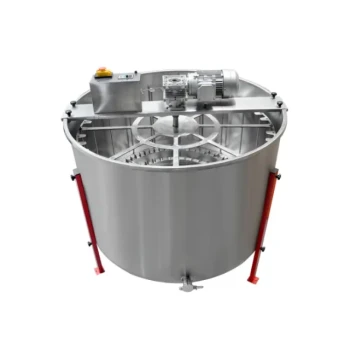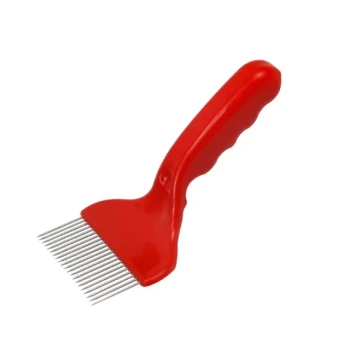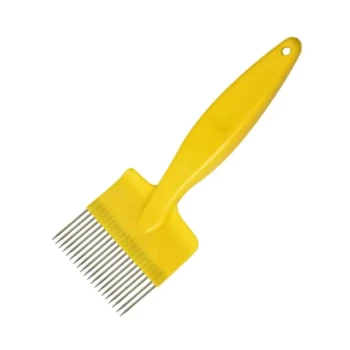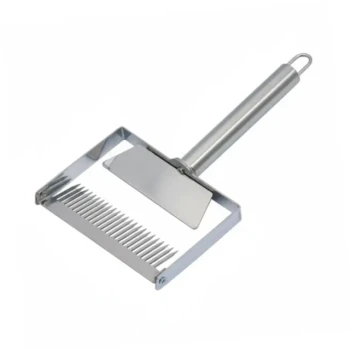In essence, a radial honey extractor is a machine that arranges honey frames like the spokes of a wheel to extract honey from both sides of the comb at the same time. It works using centrifugal force, spinning the frames at high speed to sling the honey out of the uncapped wax cells. This design is highly efficient because it eliminates the need to stop the machine and manually flip the frames to extract the other side.
A honey extractor is fundamentally a centrifuge for honeycombs. The "radial" design is a specific, highly efficient configuration that prioritizes speed and reduces labor by extracting from both sides of the frame simultaneously.
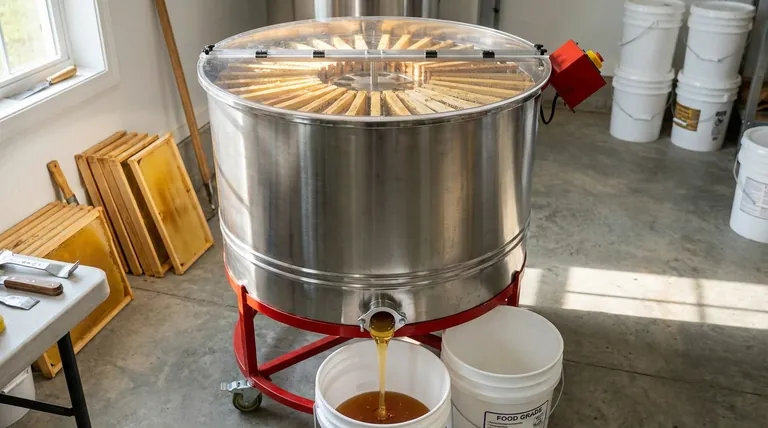
How All Honey Extractors Work: The Principle of Centrifugal Force
At its core, every honey extractor, regardless of type, operates on a single, simple principle.
The Basic Spinning Mechanism
An extractor is a large drum containing a basket or reel that holds uncapped honey frames. When the basket rotates at high speed, centrifugal force pushes the liquid honey outward, flinging it from the open wax cells.
Collection and Draining
The extracted honey hits the interior wall of the drum, runs down to the floor, and pools at the bottom. A tap, often called a honey gate, is located at the base of the drum to allow the collected honey to be drained into buckets or other containers.
The Radial Design: Engineered for Efficiency
The key difference between extractor types is how they position the frames inside the drum. The radial design is prized for its efficiency.
"Spokes on a Wheel" Orientation
A radial extractor positions frames vertically, with the top bar of the frame facing the outer wall of the drum. This arrangement resembles the spokes of a wheel radiating out from a central hub.
The Key Advantage: Simultaneous Extraction
Because of this orientation, the centrifugal force acts on both sides of the honey-filled comb at the same time. Honey is slung out of the cells on both faces of the frame during a single spin cycle.
Why This Matters: No Flipping Required
This is the primary benefit of a radial design. In other designs, like tangential extractors, the frame lies flat against the drum wall, exposing only one side. This requires the beekeeper to stop the machine, manually flip each frame, and spin them a second time. A radial extractor cuts the handling time in half.
Understanding the Trade-offs and Key Decisions
While the radial design is highly efficient, there are other factors to consider when choosing an extractor for your needs.
Manual vs. Electric Power
- Manual extractors use a hand crank to spin the basket. They are less expensive and offer precise control over speed, but require significant physical effort, especially for large batches.
- Electric extractors use a motor to automate the spinning. They are faster, far less laborious, and ideal for beekeepers with multiple hives, but come at a higher cost.
Extractor Size and Capacity
Radial extractors come in various sizes, from small 6-frame models to large units that can hold 20 frames or more. The right size depends entirely on the scale of your beekeeping operation. A larger capacity dramatically reduces the time spent processing a harvest.
A Common Pitfall to Avoid
During extraction, it is critical to drain the collected honey frequently. If the honey level at the bottom of the drum rises too high, it will submerge the bottom of the rotating basket, creating drag and preventing it from reaching the necessary speed for efficient extraction.
Making the Right Choice for Your Apiary
Your choice of extractor should align directly with the size of your apiary and your processing goals.
- If your primary focus is managing a few hobby hives: A small, manual radial extractor provides a significant efficiency boost over other manual designs without the investment of a motorized unit.
- If your primary focus is growing your apiary beyond a hobby: An electric radial extractor is a wise investment that will save you invaluable time and physical labor during harvest.
- If your primary focus is semi-commercial production: A large-capacity, motorized radial extractor is not a luxury but a necessary tool for maintaining an efficient and scalable workflow.
Ultimately, understanding the radial principle empowers you to select the tool that best fits the scale and ambition of your beekeeping journey.
Summary Table:
| Feature | Benefit |
|---|---|
| Radial Frame Design | Extracts honey from both sides of the comb at once. |
| Simultaneous Extraction | Eliminates the need to stop and manually flip frames. |
| Manual & Electric Options | Choose the right power source for your operation's scale. |
| Various Sizes Available | From 6-frame hobbyist models to 20+ frame commercial units. |
Ready to scale your honey production efficiently?
As a trusted supplier for commercial apiaries and beekeeping equipment distributors, HONESTBEE provides the durable, high-capacity radial extractors you need to streamline your harvest. Our wholesale-focused operations ensure you get the right equipment for your specific scale and goals.
Contact HONESTBEE today to discuss your needs and discover how our extractors can boost your productivity.
Visual Guide
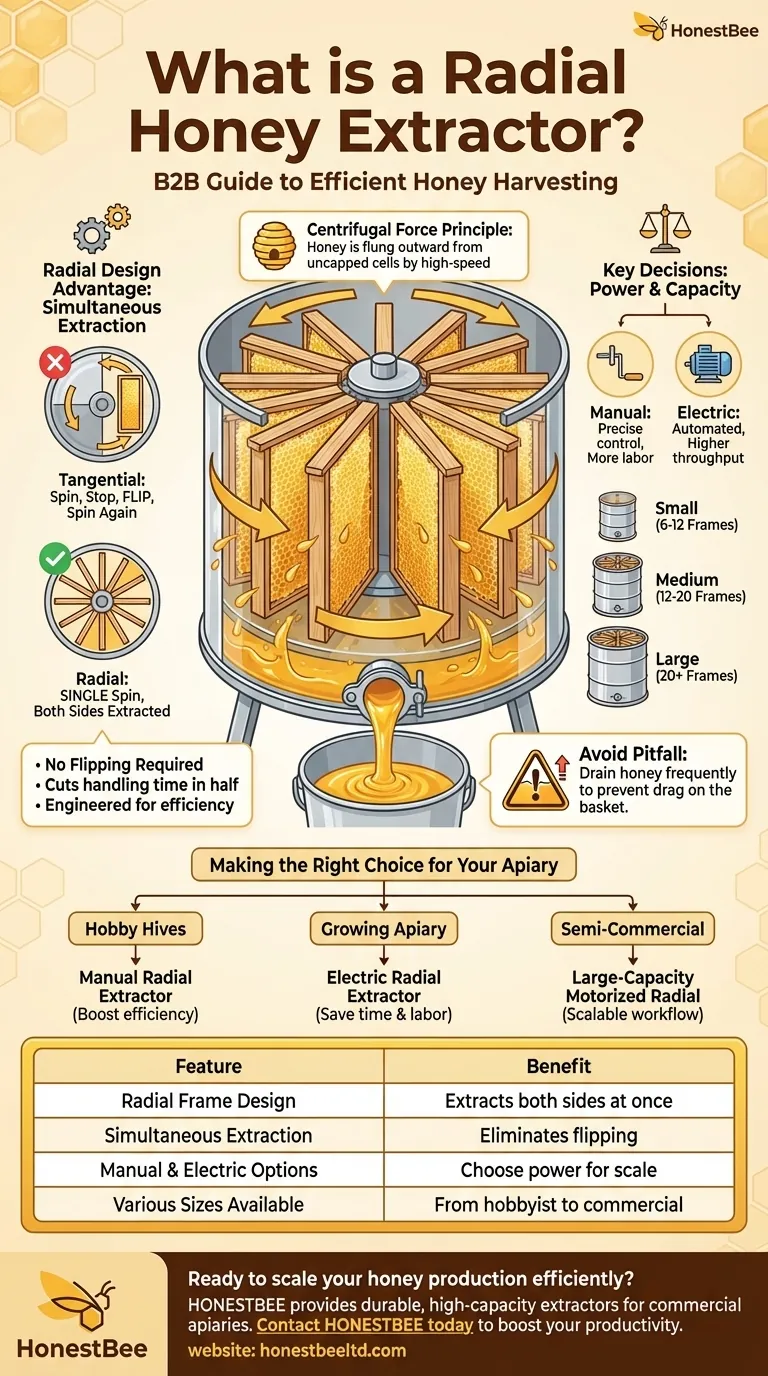
Related Products
- HONESTBEE 72 Frame Industrial Electric Honey Extractor for Beekeeping
- 24 Frame Honey Extractor Commercial Radial Honey Frame Extraction Machine
- electric honey extractor honey centrifuge 3 frame honey extractor stainless steel honey frame extractor
- 6 Frame Manual Stainless Steel Honey Extractor Beekeeping Equipment
- 40 Frame Commercial Electric Honey Extractor for Beekeeping
People Also Ask
- What are the two common types of honey extractors? Choose the Right Extractor for Your Apiary
- What are the advantages of automatic honey extractors? Scale Your Apiary with Unmatched Efficiency
- What should a beekeeper do after extracting honey from supers? A Guide to Harvest Management
- Why is preserving honeycomb integrity important, and how do automated extractors help? Boost Hive Health & Honey Yields
- What are the advantages of automated honey extractors in terms of time efficiency? Boost Your Harvest Speed




